‘Benchmark’ Also Applies to Promotions
Judge Bans MSNBC From Kenosha Courthouse
Short Takes: Malcolm X assassination; Geoff Bennett, Christopher Gasper and Gary Washburn; Dan Lothian; Sonya Ross; Fox Weather and Mississippi State University; Black News Channel lawsuit; Michael Harriot; protecting Native languages; “looting” coverage revisited; Irene Noguchi; Barry K. Young; Marshall Project in Cleveland; prison writers; Danny Fenster; repression of Cuban journalists; Cuba’s Raul Rivero; Nigerian journalist found dead; Al Jazeera bureau chief released in Sudan.
Support Journal-isms
‘Benchmark’ is 50 Percent of Hiring, Promotions
Daisy Veerasingham, incoming president and CEO of the Associated Press, and the first woman and person of color to hold the position, declared Wednesday that “I want 50 percent of hiring and promotions (to be) people of color.”
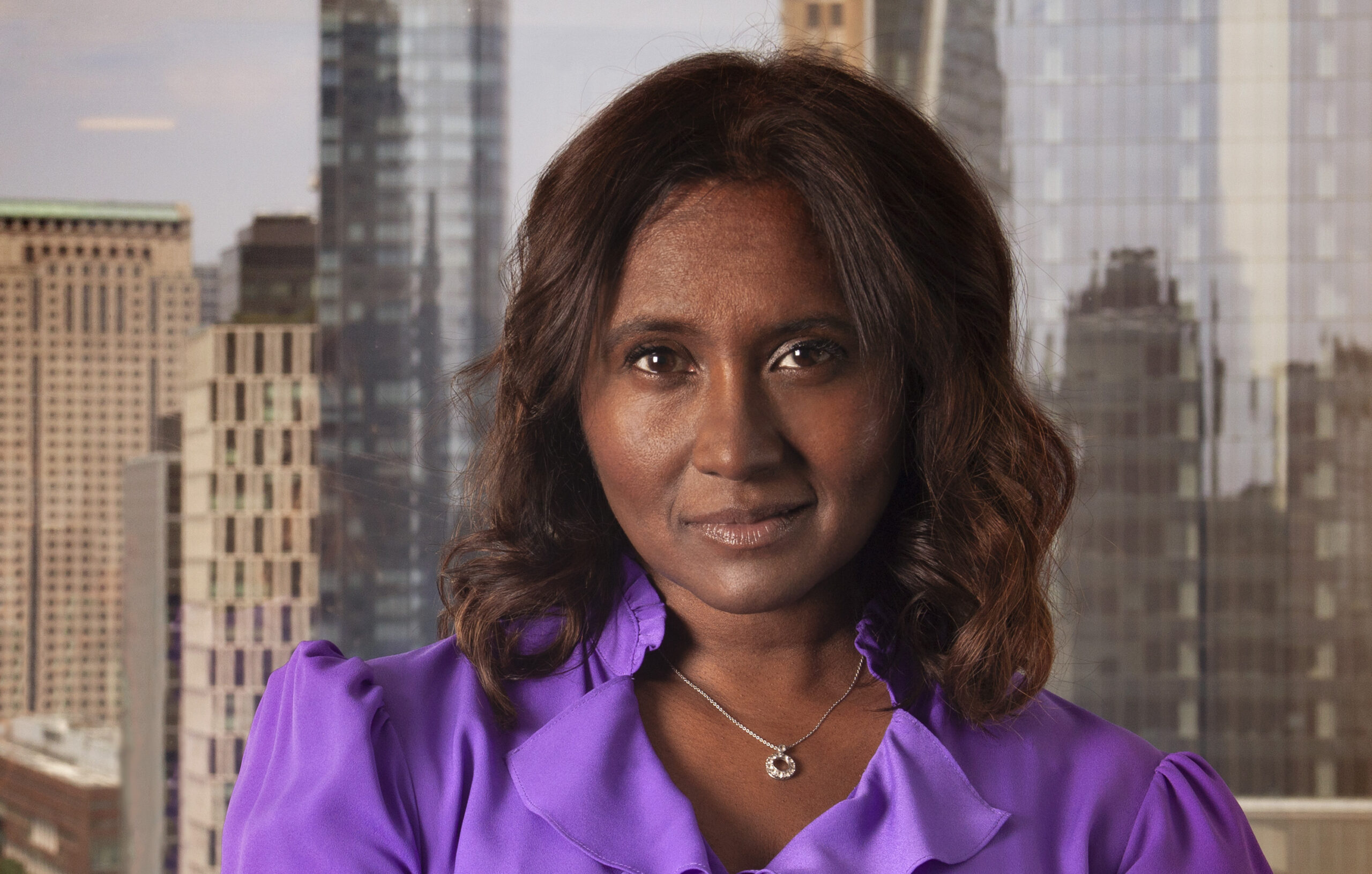 “It’s a benchmark,” Veerasingham, who is now AP’s executive vice president and chief operating officer, told a Zoom meeting of the South Asian Journalists Association.
“It’s a benchmark,” Veerasingham, who is now AP’s executive vice president and chief operating officer, told a Zoom meeting of the South Asian Journalists Association.
In fact, AP spokesperson Lauren Easton told Journal-isms when asked about this Thursday, the news cooperative has already been heading in that direction. “For the past three years, 50 percent of external News hires have been people of color,” Easton messaged.
“We announced earlier this week we plan to hire a Director of Talent in the news department, who will lead AP’s external recruitment efforts and work with AP journalists to identify growth opportunities at the company.
“One of this person’s first priorities will be the resumption of a Future Leaders program aimed in particular at increasing leadership training and opportunities for women and journalists of color. This will all be done in connection with Human Resources.”
The Future Leaders Program is “aimed in particular at increasing leadership training and opportunities for women and journalists of color,” according to Tuesday announcement from Julie Pace, AP’s new executive editor.
The three that Pace named to new executive positions include Michael Giarrusso, a member of the Asian American Journalists Association, as deputy head of global news gathering for global beats.
The Associated Press advertises that “More than half the world’s population sees AP journalism every day.”
On Wednesday, Veerasingham completed that thought, telling the journalists, “We need to look like the places in the world that we cover.” She said she believes that the AP does so overseas. But in the United States, “we have work to do,” especially with cultural diversity.
Those words sounded familiar. In 2006, Tom Curley, then AP’s president and CEO and accused of disinterest in diversity, addressed the same group in New York. Curley said afterward that “if you look at just the domestic part” of AP, “the numbers are lower than we’d like.” But overseas, he said, “we’re infused with a global cultural view that is very helpful.”
Today, the AP reports that 76 percent of its full-time news employees in the United States are white, 8 percent are Latino, 7 percent are Black and 6 percent are Asian, David Bauder reported for the AP last month. News management is 81 percent white.
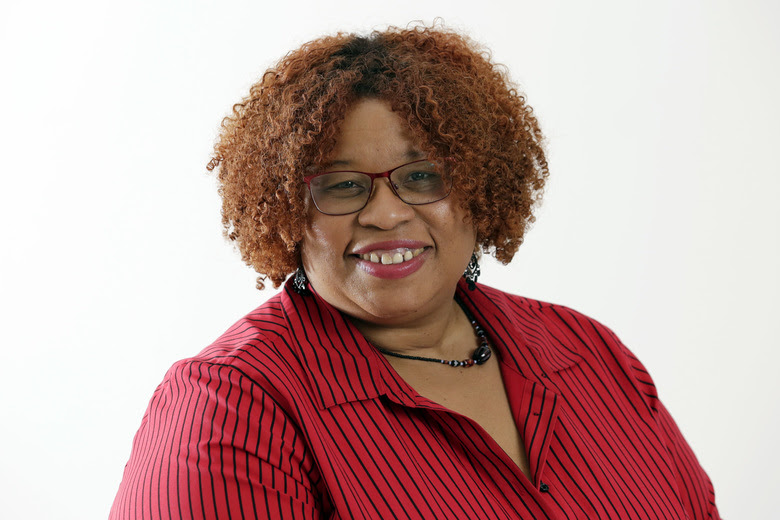 In September, Amanda Barrett (pictured), a 14-year AP veteran, was promoted to vice president and head of news audience, making her the highest ranking African American ever in the AP’s news operations.
In September, Amanda Barrett (pictured), a 14-year AP veteran, was promoted to vice president and head of news audience, making her the highest ranking African American ever in the AP’s news operations.
Veerasingham told the SAJA Zoom that for diversity to succeed, there must be a commitment from “the very top.”
The AP is not alone in fixing on a 50 percent hiring goal.
“When he began as head of news at NBC Universal last year, Cesar Conde publicly set a goal of a staff that is 50% minority and 50% women, although he gave no deadline,” Bauder noted. “Since then, monthly hires have averaged 48% people of color and 63% women, the network said. The division’s percentage of minorities has increased from 27% to 30%.”
The Gannett Co. while not fixing on a 50 percent target, announced last year that it wanted its personnel to mirror the nation’s population of women and BIPOC (Black, Indigenous and People of Color) by 2025. “Gannett also plans to increase by 30% the share of BIPOC in leadership positions. . . .,” Nathan Bomey reported then for USA Today.
Veerasingham told the SAJA audience that while her experience has been on the financial side, not journalism, one must look at the company with “a holistic view of the entire operation.” A sound financial structure undergirds the journalism, she added, and “My job is pushing the organization further than we think we are capable of going.”
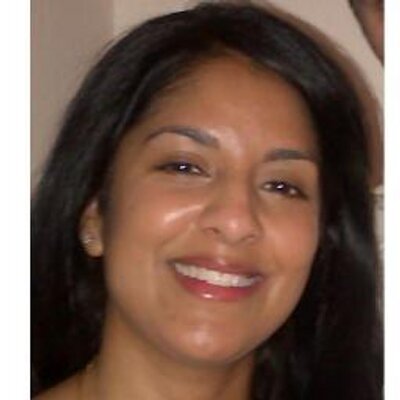 Veerasingham was interviewed by Karen Mahabir (pictured), AP fact check and misinformation editor and a SAJA board member. She asked about the new leader’s priorities, about diversity and what she considered gaps in the news coverage.
Veerasingham was interviewed by Karen Mahabir (pictured), AP fact check and misinformation editor and a SAJA board member. She asked about the new leader’s priorities, about diversity and what she considered gaps in the news coverage.
“Fact-based journalism is under threat,” Veerasingham said, citing the increasing attention that must be paid to cybersecurity and online harassment. Journalists “are hounded for essentially doing their job,” she said. Mahabir is leading an internal group focusing on keeping journalists safe online.
Veerasingham called climate “the story of our generation.”
On coverage of South Asia, Veerasingham said inequality in the region needed more highlighting, in such areas as access to health care and religious movements. She said she would like the news cooperative to do more on “power systems.”
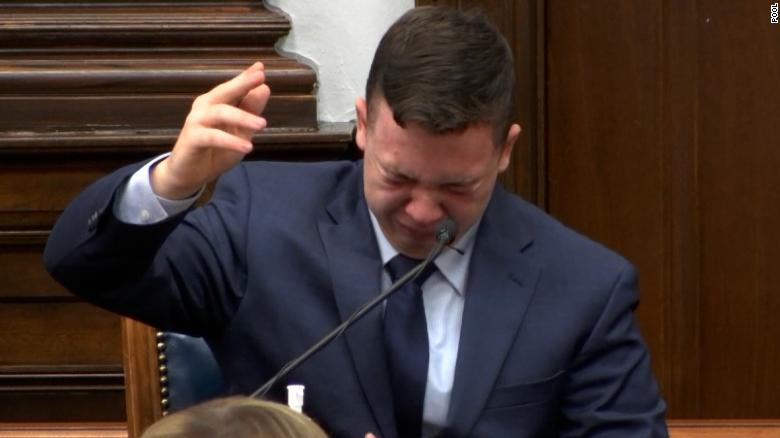
- Nov. 19 update: Kyle Rittenhouse found not guilty on all counts in Kenosha shootings case (Bruce Vielmetti, Milwaukee Journal Sentinel)
Judge Bans MSNBC From Kenosha Courthouse
“The judge in the Kyle Rittenhouse trial banned MSNBC from the Kenosha County Courthouse on Thursday after police reported that a man purporting to be working for the cable news network — or a corporate sibling — was pulled over for a traffic violation Wednesday and suspected of following the jury transport van,“ Kim Bellware and Jeremy Barr wrote Thursday for The Washington Post.
“Judge Bruce Schroeder said the man identified himself to police as ‘James J. Morrison‘ and claimed to be a producer for MSNBC acting on instructions from a New York-based producer to follow the bus. Jurors are ferried to and from the courthouse each day in a bus Schroder described as ‘sealed’ to prevent them from seeing signs, protesters or anything from either side of the contentious trial that might influence them as they deliberate the fate of 18-year-old Rittenhouse.
“A spokesperson for NBC News, the sister network of MSNBC, identified the individual as a freelancer in a statement to The Washington Post but denied an intent to make contact with jurors. . . .
“Jurors have been deliberating since Monday as they try to reach a verdict in the murder trial. Rittenhouse faces five felony charges stemming from the night of Aug. 25, 2020, when he shot three people, killing two, during unrest in Kenosha. . . .”
- Charles M. Blow, New York Times: White Men on Trial
- Robin Givhan, Washington Post: Identifying danger in the Rittenhouse case
- Renée Graham, Boston Globe: Justice, youth, and the privilege of white innocence
- LZ Granderson, Los Angeles Times: In Kyle Rittenhouse’s case, vigilantism goes on trial too (Oct. 30)
- Emil Guillermo, Asian American Legal Defense and Education Fund: #StopAAPIHate needed more than ever; Rittenhouse judge’s Asian joke
- Suzette Hackney, USA Today: Kyle Rittenhouse shot his victims, but we can’t call them that? What kind of justice system is this? (Oct. 26, updated Oct. 27)
- Tony Norman, Pittsburgh Post-Gazette: White tears over Kenosha: Kyle Rittenhouse’s masterclass in victimology deserves an Emmy, but not exoneration.
- Clarence Page, Chicago Tribune: Two racially inflamed murder cases challenge our sense of racial progress
Short Takes
- The New Yorker magazine used the news Thursday of the exoneration of two of the men found guilty of the 1965 assassination of Malcolm X to direct readers to “The Day Malcolm X Was Killed” by the late iconic Black journalist Les Payne. The piece is an excerpt from the Pulitzer Prize-winning “The Dead Are Arising: The Life of Malcolm X,” by Payne and his daughter, Tamara Payne. The Manhattan district attorney’s exoneration of Muhammad A. Aziz and Khalil Islam did not identify whom the D.A. believes were the actual killers, but the Times’ Troy Closson names possibilities, as this column did in February 2020.
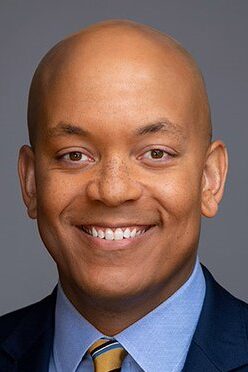 Geoff Bennett (pictured) will join “PBS NewsHour” as chief Washington correspondent, a new position, on Jan. 3 . He will also anchor the “PBS NewsHour Weekend” beginning in April, when production of the program moves to WETA from WNET/New York, PBS announced on Thursday. “Bennett was the White House correspondent for NBC News and substitute anchor for MSNBC. He will remain as a contributor for NBC News and MSNBC.”
Geoff Bennett (pictured) will join “PBS NewsHour” as chief Washington correspondent, a new position, on Jan. 3 . He will also anchor the “PBS NewsHour Weekend” beginning in April, when production of the program moves to WETA from WNET/New York, PBS announced on Thursday. “Bennett was the White House correspondent for NBC News and substitute anchor for MSNBC. He will remain as a contributor for NBC News and MSNBC.”
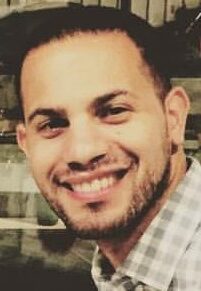 Boston sports columnist Christopher Gasper (pictured), who left the Boston Globe last year to join Boston’s WCVB-TV as a sports reporter, is returning to the Globe as a sports columnist, Gregory Lee, Globe senior assistant managing editor, talent and community, announced on Twitter Thursday. With the simultaneous promotion of Gary Washburn, the Globe now has two Black sports columnists.
Boston sports columnist Christopher Gasper (pictured), who left the Boston Globe last year to join Boston’s WCVB-TV as a sports reporter, is returning to the Globe as a sports columnist, Gregory Lee, Globe senior assistant managing editor, talent and community, announced on Twitter Thursday. With the simultaneous promotion of Gary Washburn, the Globe now has two Black sports columnists.
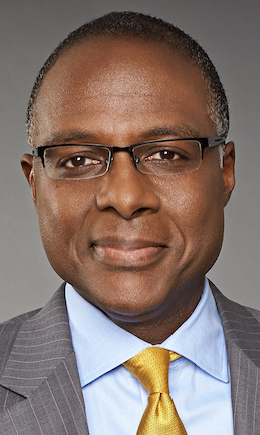 Dan Lothian (pictured), interim editor of Boston-based “The World,” public radio’s longest-running daily global news program, has been named executive producer, public media organizations GBH and PRX announced Monday. “Lothian served at CNN for more than a decade as White House correspondent and as Boston’s bureau chief; at NBC News as a correspondent in Los Angeles; at KING-TV in Seattle; and at several other local TV and radio stations. . . .”
Dan Lothian (pictured), interim editor of Boston-based “The World,” public radio’s longest-running daily global news program, has been named executive producer, public media organizations GBH and PRX announced Monday. “Lothian served at CNN for more than a decade as White House correspondent and as Boston’s bureau chief; at NBC News as a correspondent in Los Angeles; at KING-TV in Seattle; and at several other local TV and radio stations. . . .”
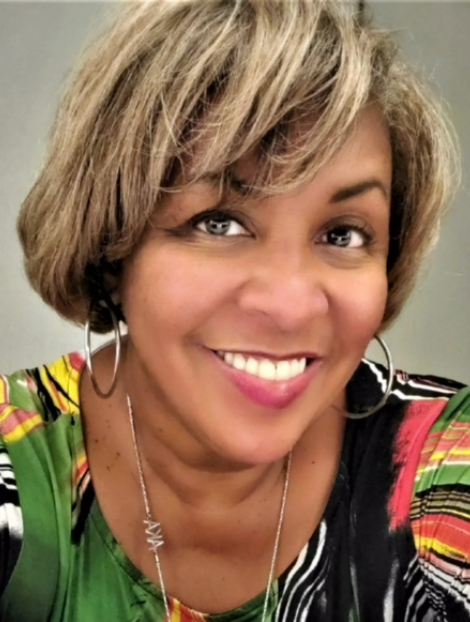 Sonya Ross (pictured) has been named managing editor of Inside Climate News, effective Jan. 1, the publication announced on Monday. “She joins ICN after a long and distinguished career at The Associated Press, where she was the editor who established specialty race and ethnicity coverage that transformed AP’s approach to gathering news for and about people of color. . . . “
Sonya Ross (pictured) has been named managing editor of Inside Climate News, effective Jan. 1, the publication announced on Monday. “She joins ICN after a long and distinguished career at The Associated Press, where she was the editor who established specialty race and ethnicity coverage that transformed AP’s approach to gathering news for and about people of color. . . . “
- Fox News Media’s new streaming service, Fox Weather, will partner with the Mississippi State University Foundation to create scholarship opportunities for students electing a concentration in broadcast meteorology or professional meteorology/climatology, the company announced Tuesday. The aim is to “further increase diversity in the meteorology field.”
- Seven plaintiffs have been added to the class-action suit against Black News Channel filed by two women claiming gender discrimination, lawyer Sheryl Ring, who is representing the women, told Journal-isms.
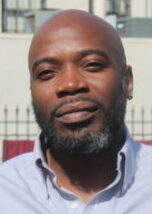 Michael Harriot (pictured), one of the more prominent writers at The Root, is leaving after five years. “I’m not moving in a new direction, nor have I decided to spend more time with my family (I wouldn’t torture them like that). This is the longest I have ever stayed with one company and I have no idea what happens next,” Harriot wrote Tuesday.
Michael Harriot (pictured), one of the more prominent writers at The Root, is leaving after five years. “I’m not moving in a new direction, nor have I decided to spend more time with my family (I wouldn’t torture them like that). This is the longest I have ever stayed with one company and I have no idea what happens next,” Harriot wrote Tuesday.
- “The U.S. Departments of the Interior, Education and Health and Human Services launched a new interagency initiative today to preserve, protect, and promote the rights and freedom of Native Americans to use, practice, and develop Native languages,” the agencies announced on Monday. They said, “For more than 150 years, Native languages in the U.S. have been subjected to suppression and elimination from a variety of factors such as federal boarding and other types of schools that forced American Indian, Alaska Native, and Native Hawaiian children to forgo speaking the language of their peoples. . . .” Interior Secretary Deb Haaland is the first Native American cabinet secretary in the history of the United States.
- In Columbia Journalism Review, Ko Bragg revisits the “looting” that took place in hurricanes Katrina and Ida. In a Nov. 10 piece, Bragg concludes, “More reporters — especially those who cover the criminal-legal system — need to accept that cops lie, and that using them as the sole source in stories presents a problem, particularly for communities of color that have heightened contact with law enforcement. This approach to sourcing is widely considered to be unacceptable for any other kind of story. Not enough reporters openly questioned whether anti-looting squads were the best use of resources during a crisis, or whether they were even effective at stemming robberies. Without those questions, reporters risk telling stories that validate expanded police details and actions. . . .”
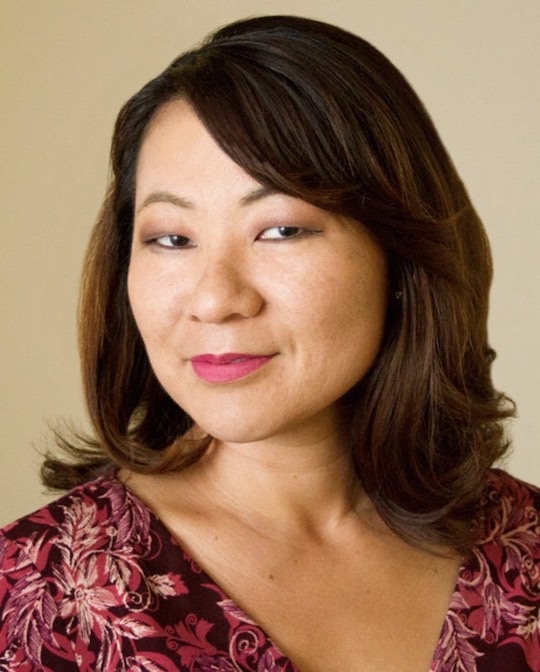 “We’re excited now to announce the next leader of Opinion Audio: Irene Noguchi (pictured), who will join as its executive producer in early December,” New York Times editors announced Wednesday. “Irene will lead the dynamic programming that includes ‘Sway,’ ‘The Ezra Klein Show,’ ‘The Argument’ and the exciting new podcast hosted by Lulu Garcia-Navarro that will launch in early 2022. Irene brings a rich background of public radio, digital media, and experience covering daily news and launching new podcasts. Irene is currently the head of audio at Politico. . . .”
“We’re excited now to announce the next leader of Opinion Audio: Irene Noguchi (pictured), who will join as its executive producer in early December,” New York Times editors announced Wednesday. “Irene will lead the dynamic programming that includes ‘Sway,’ ‘The Ezra Klein Show,’ ‘The Argument’ and the exciting new podcast hosted by Lulu Garcia-Navarro that will launch in early 2022. Irene brings a rich background of public radio, digital media, and experience covering daily news and launching new podcasts. Irene is currently the head of audio at Politico. . . .”
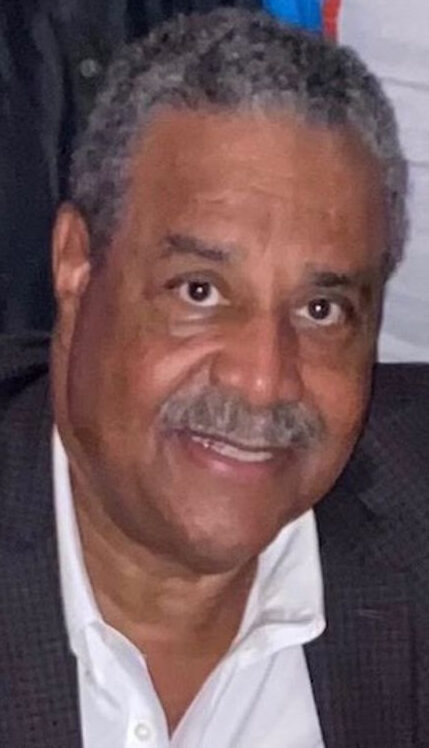 “Barry K. Young, a career Baltimore City Public Schools educator and administrator who taught English at the Bluford Drew Jemison STEM Academy West, a West Baltimore charter school for males, and earlier had been general manager of WEAA FM Radio, died of COVID-19 Oct. 28 at Sinai Hospital,” Frederick N. Rasmussen reported Saturday for the Baltimore Sun. “The resident of Baltimore’s Glen neighborhood was 69. . . .”
“Barry K. Young, a career Baltimore City Public Schools educator and administrator who taught English at the Bluford Drew Jemison STEM Academy West, a West Baltimore charter school for males, and earlier had been general manager of WEAA FM Radio, died of COVID-19 Oct. 28 at Sinai Hospital,” Frederick N. Rasmussen reported Saturday for the Baltimore Sun. “The resident of Baltimore’s Glen neighborhood was 69. . . .”
- The Marshall Project “will launch a news operation in Cleveland in 2022 with the support of the George Gund Foundation, among others, which announced a significant grant for the project this week,” the project announced Wednesday. “The Cleveland news team will report on and expose abuses in Cuyahoga County’s criminal justice system, producing investigative, data and engagement journalism with the support of The Marshall Project’s national newsroom. The Cleveland news operation will serve local audiences — including those directly affected by the criminal justice system — who are often neglected or mischaracterized in media coverage. . . .”
- “Prisoners who speak out publicly about system injustices often place themselves in danger by doing so,” Christopher Blackwell and Nick Hacheney wrote Monday for The Appeal. “Corrections officials have labeled prisoners who find success as writers and advocates as troublemakers or threat risks. As a result, prison writers may find that their communications are given a higher level of censorship, more often rejected by mailroom staff, and sometimes delayed. Corrections officials have also attempted to pit prisoners against one another, threatening to take away computer privileges for a whole group because of one person’s writings or communications. . . .”
- Danny Fenster, an American journalist who was freed earlier this week after nearly six months in jail in Myanmar, arrived in the United States on Tuesday and had an emotional reunion with his family, Ted Shaffrey and Bobby Caina Calvan reported Tuesday for the Associated Press. Fenster, who had been sentenced to 11 years of hard labor by the military government in Myanmar, was handed over Monday to former US diplomat Bill Richardson, who helped negotiate the release. Fenster is one of more than 100 journalists and publishers who have been detained since the military took over Myanmar in February, the AP reported.
- “Journalists in Cuba have been the target of repression and harassment to prevent the exercise of their profession during 15-N, a series of demonstrations called for this Nov. 15 demanding the release of people imprisoned after the protests of July 11, as well as the end of the police repression,” César López Linares reported Monday for LatAm Journalism Review. He also wrote, “Among the methods of repression against journalists registered in the days prior to Nov. 15 are extrajudicial house arrests, summons with authorities, the suspension of services, the withdrawal of accreditations, the presence of security agents near the journalists’ homes and some ‘acts of repudiation,’ as the demonstrations in which supporters of the regime gather to physically and verbally attack activists or journalists are known. . . .”
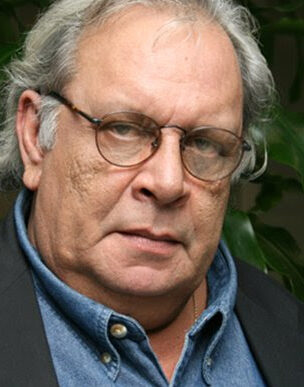 Raúl Rivero (pictured), 75, one of the best-known dissident journalists in Cuba and a fierce advocate of press freedom in the country, died outside Miami Nov. 6 of cardio-respiratory complications,” according to news reports. He “accused Fidel Castro’s Communist dictatorship of stifling dissent, emerged as the dean of Cuba’s independent press and was jailed for subversion,” Sam Roberts reported Wednesday in The New York Times.
Raúl Rivero (pictured), 75, one of the best-known dissident journalists in Cuba and a fierce advocate of press freedom in the country, died outside Miami Nov. 6 of cardio-respiratory complications,” according to news reports. He “accused Fidel Castro’s Communist dictatorship of stifling dissent, emerged as the dean of Cuba’s independent press and was jailed for subversion,” Sam Roberts reported Wednesday in The New York Times.
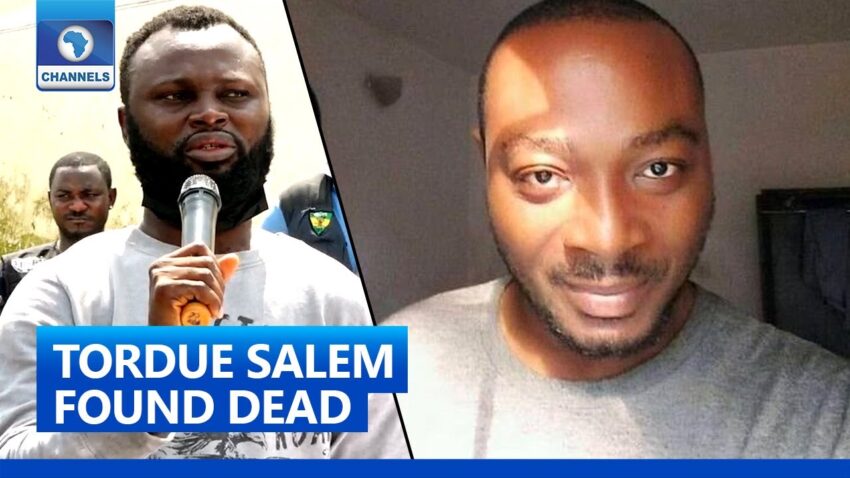
- The Nigerian Union of Journalists has demanded an independent investigation into the death of Tordue Salem, a parliamentary journalist for The Vanguard. “National police said Salem had been hit by a car (video) and his body taken to a hospital, which had not been able to identify the missing journalist,” Timothy Obiezu wrote Tuesday for the Voice of America. “But Salem’s colleagues and family are not convinced by accounts of how he died. . . . a family friend, who had spoken with the journalist’s relatives, said the body appeared to show signs of torture. The friend, who asked for anonymity out of concern for her safety, believes the journalist was privy to information that cost Salem his life but did not provide further details. . . .”
- “Authorities in Sudan have released Al Jazeera Media Network’s bureau chief in the capital, Khartoum, two days after he was arrested during a midnight raid on his home, Al Jazeera reported Tuesday. “El Musalmi El Kabbashi was released on Tuesday. The military has yet to give a reason for his detention. The journalist was among hundreds of people taken into custody amid mass protests across Sudan against a military power grab last month that disrupted the country’s transition towards civilian rule after the 2019 removal of longtime ruler Omar al-Bashir in the wake of popular protests. . . . On Wednesday, dozens of journalists gathered in central Khartoum near the military headquarters to denounce what organisers said was a ‘campaign to target journalists’. ‘In dictatorships, journalism dies; they will target journalists directly and they will terrorise them, because they know that journalism is the backbone of democracy,’ said Mohamed Said, a journalist at al-Hadatha newspaper, which has suspended operations following the coup. . . .”
Dropping the Ball on Covering the Sisterhood
November 15, 2021
And Other Tales of Black Women’s Media Issues
Homepage photo credit: Lifetime/MSN
Support Journal-isms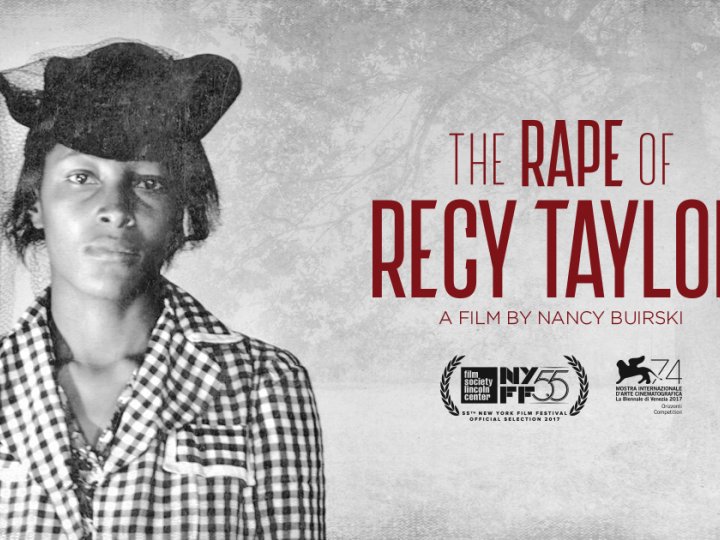
And Other Tales of Black Women’s Media Issues
It came to the Associated Press as a request for a book review. It was 2010, and Danielle L. McGuire had written “At the Dark End of the Street: Black Women, Rape, and Resistance — a New History of the Civil Rights Movement From Rosa Parks to the Rise of Black Power.”
But inside the book was the story of Recy Taylor, a 24-year-old Black woman who was gang-raped by white men when she was walking home from a church revival in her small Alabama town on the evening of Sept. 3, 1944.
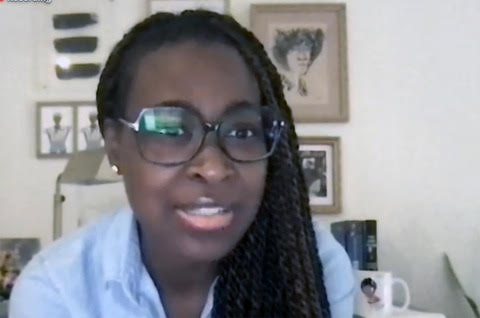 When Sonya Ross, then the AP’s race and ethnicity editor, and Errin Haines (pictured), then a reporter in the AP’s Atlanta bureau, started talking, Ross remembered declaring, “Screw the book review, let’s find this lady, because the logical question was, ‘How do you feel about the lack of justice for your case?’
When Sonya Ross, then the AP’s race and ethnicity editor, and Errin Haines (pictured), then a reporter in the AP’s Atlanta bureau, started talking, Ross remembered declaring, “Screw the book review, let’s find this lady, because the logical question was, ‘How do you feel about the lack of justice for your case?’
“Errin tracked Recy Taylor. And the question to her, ‘Would you like an apology?’ something that simple, led to an amazing thread of reporting that was done. This wonderful lady Recy Taylor had received an apology from her hometown and an apology from the state of Alabama.
“She had been the subject of a documentary, and by the time she passed away a few years ago, she was well aware that she was loved, and that she was appreciated and there was somebody on her side.
“And really that’s what any of us want when we cover these stories,” Ross told the Journal-isms Roundtable Zoom session on Sunday afternoon, Nov. 7. “When we put our voices out there, or when we go out there with an open ear to hear what our sisters are saying, and that is why it is so important to have discussions like . . . we’re having now and I hope that they will continue going forward. . . .
“That was amazing, amazing work.”
The lesson, attendees believed, was what can happen when Black women control the narrative.
Fifty-nine people were on the Zoom, with another 85 watching on Facebook. (Credit: YouTube)
Ross, who retired from the AP in 2019 after 33 years, including notable service as a White House correspondent, is founding editor of the website blackwomenunmuted.com. She was part of a panel moderated by Nichelle Smith, enterprise editor for racism and history at USA Today; Haines, editor-at-large at The 19th; dream hampton, showrunner and executive producer of the 2019 “Surviving R. Kelly” documentary series; and Yanick Rice Lamb, publisher of fierceforblackwomen.com and journalism professor at Howard University.
Fifty-nine people were on the Zoom, with another 85 watching on Facebook and 82 tuning in the reposting on YouTube as of the following Sunday, Nov. 14. Only 10 of those on the Zoom call were men, with others opting for watching an NFL game, an issue raised disapprovingly by the women in attendance, who said one should be able to do both.
You can watch the Roundtable video here or click on the image above.
Ross surfaced another issue with wider significance — undercoverage of news about Black women seeking political office.
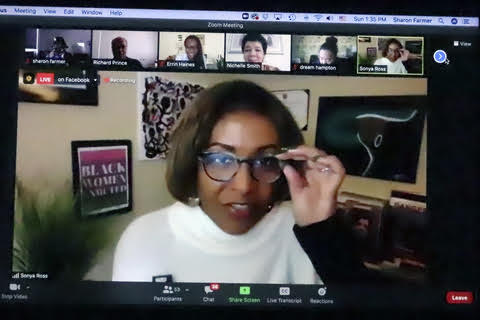 “It started with a vengeance really, although it was happening before,” Ross (pictured) continued. “It started with a vengeance in 2017 with that outsized Black female vote participation in Alabama that lifted a Democrat,” Doug Jones, “to the U.S. Senate. Exit poll data . . . found that 98 percent turnout by Black women, the strongest and most loyal participation of any voting demographic that was measured in that election.
“It started with a vengeance really, although it was happening before,” Ross (pictured) continued. “It started with a vengeance in 2017 with that outsized Black female vote participation in Alabama that lifted a Democrat,” Doug Jones, “to the U.S. Senate. Exit poll data . . . found that 98 percent turnout by Black women, the strongest and most loyal participation of any voting demographic that was measured in that election.
“And there was lots of focus on it, lots of talk about it. Virtually no follow-up, because what happened right after that 98 percent is there were 70 Black women on various ballots, and Alabama the following year in 2018, and without actual media attention paid to that, they didn’t get the publicity they deserved, ergo so many of them did not get elected. So here we are in 2021 with the sisters still holding up a revolution, and very little focus being given to that.
“So while there is a large applause for the accomplishment of Kamala Harris, being elected vice president of the United States and really the highest office that any woman has held, we still have so much holding us back . . . And so much that needs to be reported that’s not getting reported . . . it’s still an under-told story. And it’s so very important for us to be out there reporting our own story, controlling that narrative, because we can bring the focus to that narrative that’s necessary.”
Haines said in introducing herself as editor at large of the 19th, founded in January 2020, “Part of the reason we started this newsroom [was] with the idea that political journalism had been too white and too male for too long.”
hampton is now best known for “Surviving R. Kelly,” the 2019 documentary series on Lifetime that renewed the interest that led to the R&B singer’s trial and conviction for sexual exploitation of a child, racketeering, bribery and sex trafficking.
Thirteen incarcerated men helped co-direct dream hampton’s visceral documentary about life in prison. (Credit: YouTube)
hampton allowed that she is much more than that series. “You might guess that I’m tired of talking about ‘Surviving R. Kelly,’ ” she said. “That same year, I did a six-part documentary series — I’m at BET — called ‘Finding Justice,’ that had nowhere near the amount of eyes on it that ‘Surviving R Kelly’ did.” “Finding Justice” examined police brutality and voting rights.
hampton did other relevant work for HBO. ‘It’s a Hard Truth, Ain’t It‘ was filmed at Indiana’s Pendleton Correctional Facility, following 13 incarcerated men as they studied filmmaking as a vehicle to explore their memories, as well as how they ended up with decades-long sentences.Despite Kelly’s conviction, the news media are not giving abusive Black men the attention they deserve, hampton said. “It became clear that there wasn’t going to be a shift in this ‘pimp culture’ that celebrates R. Kelly, if not celebrates him then at least looks the other way. That kind of shift I’m hoping happens, but I don’t see it as something that’s on the horizon,” the documentarian added.
In the week following his guilty verdict, Kelly’s music saw double-digit growth in streams and a triple-digit growth in sales, the Houston Defender reported.
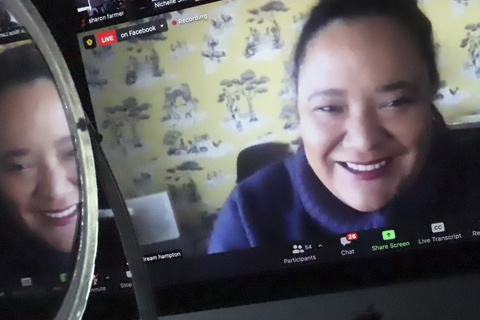 hampton (pictured) continued, “You know I remember The New York Times published 100 people who had lost their jobs or their position or power because of the #MeToo movement. Two of them were Black.
hampton (pictured) continued, “You know I remember The New York Times published 100 people who had lost their jobs or their position or power because of the #MeToo movement. Two of them were Black.
“One of them was Bill Cosby. And so in our minds, though, we have this idea as Black folks that there’s been this over-indexing on targeting Black men, and I know that’s connected to a history. We brought up Ida B. Wells. Her work is largely about Black men being falsely accused of sexual violence. But at the same time, this was a movement that actually wasn’t talking about people who’ve been accused, like AJ Johnson, like Russell Simmons.
“I can think of a half dozen men who haven’t had the kind of spotlight put on them that, say, Jeffrey Epstein or Harvey Weinstein has. . . .
” We have wrongly thought that this is over-indexed on targeting Black men, and I do hope that changes, but sometimes these narratives can be much stronger than the truth.”
The Times story has since been updated; hampton says her point remains.
What’s not over-indexed is coverage of everyday Black women, Lamb said.
“We continue to see in news that there aren’t enough everyday women being covered in some of the women who are on the ground and behind the scenes . . . We see a lot of women who are already in the spotlight. Sometimes in coverage we see a disproportionate coverage of celebrities, and then some of the everyday women have been covered in terms of Covid 19 as being frontline workers, essential police, things like that.
“But . . . after that pandemic disappears, we definitely want to see more of that going forward, and we hope this is not just a spurt. Because, you know, women have been doing these things . . . for years, for decades. . . . It’s nice to have this moment, but we also remember seeing some of the initial [negative] coverage of Michelle Obama, and how that felt to a lot of Black women. . . .”
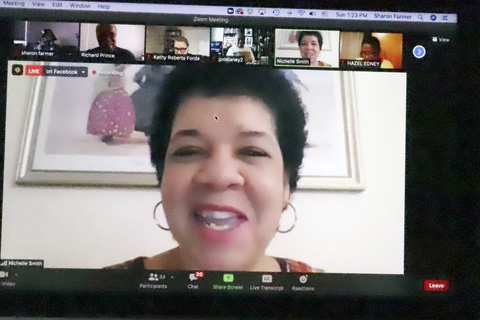 Smith (pictured) recalled that Obama “was on the one hand vilified in one hand and [on the other hand] celebrated, and it seemed — as if to me at least — as if the next administration worked very hard to remove all trace of her.”
Smith (pictured) recalled that Obama “was on the one hand vilified in one hand and [on the other hand] celebrated, and it seemed — as if to me at least — as if the next administration worked very hard to remove all trace of her.”
Lamb cited gender-gap reports from the Women’s Media Center and the Associated Press Sports Editors, and “Color Caste and the Public Sphere: Black journalists who joined television networks from 1994 to 2014,” a 2018 study from Howard University professors Indira S. Somani and Natalie Hopkinson. “Some of that was also looking at the pressure to have their hair conform or their dress or other aspects of their personality or their appearance conform to the norms [of] their stations or their networks,” the study said.
The treatment of Black women over the years amounts to human rights violations, retired journalist Kenneth Walker told the group, worthy of consideration by the United Nations. Walker called the United States an “active crime scene.”
“There are several processes throughout the country, taking evidence and hearing testimony about a number of anti-Black atrocities,” Walker messaged afterward.
“Law, police violence, medicine are just three areas being explored. The plan is to present the evidence to the United Nations in support of an international branding of the U.S. as guilty of crimes against humanity. That’s what I meant by active crime scene. The media, including most Black journalists, are ignoring these processes. And we shouldn’t be.” He sent a link to this story.
Ross was thinking similarly. “Maybe what we need to do as a people is to take our clues from South Africa, where our industry is concerned. Why can’t we have a Truth and Reconciliation Commission to take testimony from journalists over the generations, about the impact of being in this industry? And what it does to their psyches, our psyche, collectively and individually as Black Americans?
“I think that sort of information gathering is not dependent upon any media organization to make their people available for it. And it would be the people who are on the receiving end of the discrimination articulating the problem.”
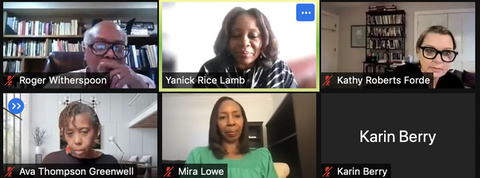
The Roundtable began with a toast to Mira Lowe, who started the previous week as dean of the FAMU School of Journalism and Graphic Communication (scroll down). In addition to getting acquainted with the school and her primary duty of fundraising, Lowe said she was “looking [at] how we can better tell our story. FAMU has a very storied history. The school produces quality alumni, but I’m not sure we’ve done a great job of telling the story and all the accomplishments of our alumni and our current student body, so [we’ll] be looking to do more storytelling as a school of storytellers.”
We toasted Neil Foote and Rochelle Riley, Journal-isms Inc. board members who have been selected for induction to the Hall of Fame of the National Association of Black Journalists.
We congratulated Fergus Shiel, managing editor of the International Consortium of Investigative Journalists, which in October made news worldwide when it premiered “The Pandora Papers,” its latest investigation, conducted by a team of journalists around the globe who looked at the world of offshore finance and the people — and countries — who suffer when illicit money goes offshore. Shiel called it the biggest journalism project in history, with 600 journalists and 117 countries from 150 publications involved.
Kamesha Laurry, Borealis Racial Equity in Journalism Fund legal fellow at the Reporters Committee for Freedom of the Press, introduced herself. Her work focuses on identifying, supporting and addressing the legal needs of journalists, reporters and documentary filmmakers of color.
Still, it was the main discussion that hit home for many. “This has been one of the most relevant panels you have ever had. I am on the verge of tears,” Hazel Trice Edney, founder of the Trice Edney News Wire, said before asking her question.
Riley wrote in the chat room, “We should do the Women Takeover quarterly.”
Kathy Roberts Forde, co-editor of the forthcoming “Journalism and Jim Crow: White Supremacy and the Black Struggle for a New America,” the topic of the upcoming Dec. 12 Roundtable, wrote, “This panel is extraordinary — and all of you panelists are a gift and,” she added, “please God changing this world through your work.”
- Inside Climate News: Sonya Ross Joins Inside Climate News as Managing Editor
To subscribe at no cost, please send an email to journal-isms+subscribe@groups.io and say who you are.
Facebook users: “Like” “Richard Prince’s Journal-isms” on Facebook.
Follow Richard Prince on Twitter @princeeditor
Richard Prince’s Journal-isms originates from Washington. It began in print before most of us knew what the internet was, and it would like to be referred to as a “column.” Any views expressed in the column are those of the person or organization quoted and not those of any other entity. Send tips, comments and concerns to Richard Prince at journal-isms+owner@
View previous columns (after Feb. 13, 2016).
View previous columns (before Feb. 13, 2016)
-
- Diversity’s Greatest Hits, 2018 (Jan. 4, 2019)
- Book Notes: Is Taking a Knee Really All That? (Dec. 20, 2018)
- Book Notes: Challenging ’45’ and Proudly Telling the Story (Dec. 18, 2018)
- Book Notes: Get Down With the Legends! (Dec. 11, 2018)
- Journalist Richard Prince w/Joe Madison (Sirius XM, April 18, 2018) (podcast)
- Richard Prince (journalist) (Wikipedia entry)
- February 2018 Podcast: Richard “Dick” Prince on the need for newsroom diversity (Gabriel Greschler, Student Press Law Center, Feb. 26, 2018)
- Diversity’s Greatest Hits, 2017 — Where Will They Take Us in the Year Ahead?
- Book Notes: Best Sellers, Uncovered Treasures, Overlooked History (Dec. 19, 2017)
- An advocate for diversity in the media is still pressing for representation, (Courtland Milloy, Washington Post, Nov. 28, 2017)
- Morgan Global Journalism Review: Journal-isms Journeys On (Aug. 31, 2017)
- Diversity’s Greatest Hits, 2016
- Book Notes: 16 Writers Dish About ‘Chelle,’ the First Lady
- Book Notes: From Coretta to Barack, and in Search of the Godfather
- Journal-isms’ Richard Prince Wants Your Ideas (FishbowlDC, Feb. 26, 2016)
- “JOURNAL-ISMS” IS LATEST TO BEAR BRUNT OF INDUSTRY’S ECONOMIC WOES (Feb. 19, 2016)
- Richard Prince with Charlayne Hunter-Gault,“PBS NewsHour,” “What stagnant diversity means for America’s newsrooms” (Dec. 15, 2015)
- Book Notes: Journalists Follow Their Passions
- Book Notes: Journalists Who Rocked Their World
- Book Notes: Hands Up! Read This!
- Book Notes: New Cosby Bio Looks Like a Best-Seller
- Journo-diversity advocate turns attention to Ezra Klein project (Erik Wemple, Washington Post, March 5, 2014)
When you shop @AmazonSmile, Amazon will make a donation to Journal-Isms Inc. https://t.co/OFkE3Gu0eK
— Richard Prince (@princeeditor) March 16, 2018

